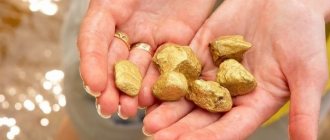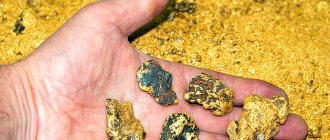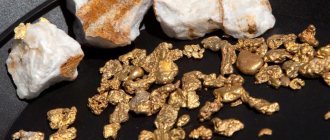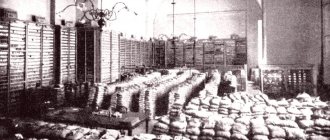Since ancient times, rivers, streams, waterfalls and beds of dry water streams have attracted gold seekers to their banks. Most prospectors are attracted by the opportunity to get rich quickly, but there are also those who are driven primarily by sporting interests. If a person is wondering how to find gold in a river and where to look for it, he should study the basics of geology, hydrology, collect all possible information about the search location and arm himself with the necessary equipment.
Where to look for and pan for gold
Noble metal carried by water flow is called alluvial metal. Such gold breaks off from the bedrock under the influence of gravitational forces, weathering and chemical attack. Placers of precious metal are terraced, bottom and spit.
The first signs of the presence of a deposit are often found along river banks. A water stream with a strong current gradually cuts deeper and deeper into the surface of the earth, forming terraces at the upper level. Large deposits of terraced gold can be found not only near existing rivers, but also in places where streams have long since dried up.
Bottom deposits are formed as a result of the seepage of metal particles through dense layers of rock to the bedrock bed. Experts recommend looking for gold where the bedrock is shallow. On the river bank, mining from placers located on sand or pebble spits can bring success.
The noble metal does not always reach the bedrock. It can become stuck in dense clay if the current is not strong enough to wash it away. Gold is heavier than clay, but it cannot penetrate through several layers of well-compacted material. In this case, the precious metal must be looked for close to the surface of such false bedrock.
Particles of yellow metal move only where the flow speed is high. In mountain streams and rivulets you can try your luck near large boulders, where natural traps form. In these places, the current slows down sharply and the golden sand sinks to the bottom. Such “pockets” most often form in front of and directly behind large boulders. A more attractive trap is the one downstream, where the gold is purer.
The most interesting areas to search are places where the strength of the flow decreases. At bends in the riverbed, gold in rivers moves under the influence of centrifugal forces. On the outside of the stream the flow is faster than on the inside. Accordingly, the sandbars and spits at the beginning of the inside turn are good places to explore.
The flow moves most powerfully during the spring flood. At the same time, the channel expands and changes its boundaries. It is useful to measure its width and calculate the core of the river, taking into account its bends. Metal particles always follow the shortest path. When the river returns to its original state, searches should be conducted along the calculated trajectory.
The speed of the flow slows down sharply at the point where the tributary flows into a lake or other river. Accordingly, the zone of potential gold deposition will be the beginning of the mouth. You can start your search in the area where the river exits the mountains onto the plain. The optimal place is the area where a stormy stream flows into a river.
Of interest to gold miners are waterfalls, under which a whirlpool and a pit form. This is a kind of natural filter for gold sand and nuggets. First of all, you should pay attention to the area where the flow exits the pool. Sometimes gold can be found right where the water falls. It is also recommended to examine the boulders.
Gold is 19 times heavier than water. It does not float, but drags along the bottom of the river. Therefore, it is necessary to look for the noble metal where barriers are erected in the path of the flow. Cracks and caverns, boulders, fallen tree trunks, shallows, spits, ledges and irregularities, holes and whirlpools are the main places for prospectors to explore.
Yellow metal satellites
The list of minerals that coexist with gold is quite long. Silver is most often found together with the noble metal. Other satellites: platinum, quartz, adularia, galena, pyrite, lead. The combination of these elements with gold can be very different.
However, the presence of these minerals does not always indicate the presence of yellow metal. But if a nugget is found, it always contains silver. Its share can range from a few tenths of a percent to significant amounts. The optimal ratio of the two precious metals is found in volcanic rock.
Necessary tool
Prospectors use special equipment to identify gold. The most traditional device is a metal detector, which allows you to probe the soil to a depth of 15 cm to 1 m. The main problem is its excessive sensitivity. The device is not tuned to yellow metal, i.e. the signal from iron and gold will be the same.
Today, more advanced special instruments have been developed that make it possible to search for nuggets at a depth of up to 1 m. This gold probe is equipped with a probe with a sensor device. A signal about the presence of a precious metal is given by direct contact with it. Unlike a metal detector, this equipment is not sensitive to soil type.
Searching with a metal detector
To search for gold in the ground and river beds, you must correctly set the sensitivity of the metal detector. The number of false signals that the device gives depends on it. It is also necessary to configure the ground balance function. This parameter will have to be adjusted every few minutes, since the composition of the soil is constantly changing.
When working with a metal detector, the coil should be kept as close to the ground as possible. When a signal is received, it is recommended to “listen” to the soil in all directions. If the sound fades quickly, then the signal is false. A similar check is carried out by lifting the coil up.
Gold mining. How to find gold? Searching with a metal detector
Gold mining methods
According to statistics, the average gold content in the lithosphere is about 4.3·10−7% by mass. Man has been mining this precious metal for a long time and every time he is convinced that it is not so simple. There are not a large number of methods for extracting gold, but there are only two main ones: the first is washing sand from the river and the second is extracting gold-bearing rock from mines, which contains small inclusions of the yellow metal. From such gold-bearing rock, the precious metal is extracted using the processes of amalgamation, chlorination, and also the cyanide method.
Over the entire existence of man, he has extracted a huge amount of gold, approximately 168.9 thousand tons, this figure is current for 2012. Of all this metal, 50% was used for the production of jewelry, 12% was used for industrial and technical purposes, and the remaining 38% is stored in banks.
If you collected all the gold mined by man and made it into a cube with an edge, then its thickness would be 20 meters, and the height would be the height of a five-story building. All the ore and all the sand from which such an amount of gold was mined, collected in one place, would form a mountain whose height would be more than 2.5 km.
Traditional gold mining methods
The basic traditional methods of gold mining are quite simple and are still incredibly resilient to this day. With their help, people mined gold one hundred and two hundred years ago, and in our modern times, mining methods have not changed. The only thing that has changed is that previously people did almost all the work by hand, but nowadays a lot of work is done by machines.
All gold lovers are definitely interested in the question of where to look for this coveted metal. In this article we will try to understand this complex issue.
Everyone is well aware that one of the main sources of gold production is gold-bearing rivers. After heavy winter or summer rains, floods often form, which wash away rocks that may be gold-bearing into various rivers and streams.
The seething water isolates small particles of precious metal, which, under the influence of gravity, settles at the bottom of the river and an experienced gold miner can pan for gold using a wooden tray. However, after two or three weeks, a thin layer of river sand, in which gold particles remain, may become covered with a layer of silt or overgrown with algae, after which the extraction of gold particles becomes more difficult.
Therefore, when the hot summer comes, it is time for gold miners and prospectors. They understand that there is no time to waste and begin a rather labor-intensive process.
Their main and main task is to get and wash as much rock from the river as possible. Miners work almost around the clock, as long as they have strength. They try, but the results may not always please them.
The initial goal of gold miners is to wash a bag or better of two with gold sand, which, as the heaviest part of the rock, will settle to the bottom of the tray. This work requires enormous effort, since you have to work in very cold mountain water and the only thing that warms you up is waiting for the catch.
Based on communication with several people - gold miners, it became clear to me that you need to look for gold sand in those parts of the river where there is no strong current, where the river has a wide channel, and it would also be nice if some other river flowed into this place.
It is desirable that the area where the river flows be mountainous, since it is more likely that water flowing over mountainous, gold-bearing rock will bring small particles of the precious metal.
I also learned that river rock is determined for its gold content by certain criteria, and one of them is the presence of quartz particles.
Modern gold mining technologies
Nowadays, technology has advanced greatly. Gold is mined using the heap leaching method. This technology makes it possible to extract metal from poor ores, from small deposits, as well as to develop off-balance ores.
It only takes one year to implement heap leaching technology, which is very acceptable for a private gold miner, and is also a good investment. In a year you will be able to hold gold bars in your hands. Moreover, the costs will be less per kilogram of gold mined than by the traditional factory method.
This technology includes several stages of the production process. At the beginning, it is necessary to prepare the ore material, it is crushed into small fractions using special mills, then the rock should be passed through a system of sieves and pelletized so that the ore does not stick together and does not collect into large fractions.
The next stage is the formation of an ore stack by leaching the ore with a cyanide solution. This process is very poisonous. Extraction from ore by sorption of heavy metals using ion exchange resin or activated carbon. There is another method, which is produced using zinc metal, by carburizing.
The next stage is obtaining gold deposits on the cathode or zinc deposits that contain gold. All this happens in a galvanic bath.
Then a master alloy is obtained by melting gold-bearing sediments and the remaining ore is leached, also called tailings, and the land from which the rock was taken is reclaimed. The Irgiredmet Institute is one of the creators of this technology. This method was first used in 1991 in Kazakhstan at the Vasilkovsky GOK.
A little later, in 1994, it began to be used in Russia at ZAO ZDK Zolotaya Zvezda, at the Mayskoye deposit. Then more than 38 gold mining installations were launched in the northern territories. They were located in Yakutia, the Amur and Chita regions, the Northern Urals, and the Krasnoyarsk Territory.
In 2009, the gold mining industry showed strong results in the Urals, despite a serious economic crisis. All 24 gold mining enterprises in the Urals were not affected by the crisis, unlike other regions, since gold remained a highly liquid commodity and there were no problems with its sales.
This high result was achieved thanks to new gold mining technologies, as well as rising prices for the precious metal.
However, modern gold mining technologies, practically eliminating manual labor, shovels and wheelbarrows, have their drawbacks. These include huge costs of electrical energy.
For example, to extract a kilogram of gold at the Berezovskoye deposit, 130 thousand kWh of electricity will be consumed. With the constant increase in electricity tariffs, the profitability of gold mining is steadily decreasing every year.
Despite these expenses, almost a kilogram of precious metal per employee is produced per year, and this is a much higher figure than with previous old technologies in the same deposits.
Gold dredge
Many years have passed since man began to mine gold and basically the technology has not changed in principle. It’s just that manual labor has been replaced, in some cases, supplemented by the work of machines.
Washing gold ore in a wooden tray is now not relevant for large gold miners, but the principle of the technology remains the same, only the size of the tray has changed, the number of trays has changed, there are many of them with sequentially located finer meshes.
The most common means for washing river rock is a dredge. This is a huge, noisy device that is designed to extract gold from river rock. Rumbling like a dragon, this unit produces loud sounds.
The dredge has a long tail and neck, in which conveyors are located inside. The head of the dredge is lowered into the water, it swallows wet river rock, which enters the body of the dragon, where, with the help of people, the rock is sifted, and waste rock comes out of the tail.
Dredging is certainly an effective way to extract gold, however, it greatly harms the ecology of river banks, since after dredging, river beds look terrible. Rock dumps and continuous dug holes on the river look like after a bombing.
Gravitational differentiation
This gold mining technology is based on the process of grinding gold-bearing rock. After the rock is loaded onto dump trucks and tractors by huge excavators, it is transported to special mills, which are cascaded inside huge rotating drums. In them, the rock is crushed with large cast iron balls.
After which it is fed into centrifuges, where the heaviest fractions of the rock are carried to the edge. Repeated turning will melt the heavy metal particles. Gold is most often found in pyrite particles. Pyrite is an associated mineral. Together with gold, they are much heavier than the rest of the rock. In the past, people always confused the shine of pyrite with the golden glow of the real precious metal.
Then the resulting composition of fine gold-bearing rock is washed several times, from which small gold grains are selected, since the heavy fractions settle to the bottom.
Finding gold with a metal detector
A large number of people believe that due to the very low percentage of gold content in the already mined ore, it does not make any sense. After all, to get one gram of gold, you have to shovel a huge amount of rock.
The average gold content in the earth's crust is only about 5 milligrams per ton. If you think like this, then mining the yellow metal by any method will never be profitable: neither artisanal nor industrial.
However, in the earth's crust there are local places rich in gold, they are called deposits. They are discovered by geologists who have the appropriate education. In such gold deposits, the content of precious metal is several orders of magnitude higher.
Also, in the deposits themselves there are areas that are much more enriched in metal, they are called ore nests and pillars. The gold content in such places can reach more than one kilogram per ton of rock. The ratio of the weight of mined gold to the remaining processed rock estimates the effect.
How to find areas of land rich in gold? There is an answer! In our modern times, metal detectors have been invented and are actively used. With their help, you can dramatically increase the speed and efficiency of searching for precious metals. If you find something gold with a metal detector, then you need to examine this place more carefully, try to wash the rock in this place.
As practice shows, a piece of gold cannot be found entirely alone; usually other specimens are found not far from it. They began searching for gold abroad with the help of metal detectors about 40 years ago; since then, quite sensitive metal detectors have appeared that are capable of finding small gold nuggets.
Employees of the Geology Research Institute tested a huge number of models of metal detectors; they were tested in various conditions, on land and in water. As a result of the tests, it was proven that metal detectors are excellent for searching for nuggets in various conditions.
During the research that was carried out in the Irkutsk region, more than a hundred nuggets were found that weighed more than a kilogram. It is very difficult to detect gold nuggets on the surface of the earth; this happens mainly in movies. They are more often found on the surface of dumps that remain after the development of large industrial deposits.
Let's try to figure out where to look for nuggets. Promising areas for gold are of different types and, therefore, you need to look for them in different places. The most reliable and proven option is to search in those areas where gold mining has previously been carried out or is currently underway. Places where gold has never been mined are considered completely unpromising.
You need to take into account the fact that someone was already looking for gold before your arrival and this circumstance is a huge plus. Professional geologists examined all the streams, caves and mountains. They worked in large groups for many months and if they couldn’t find anything, then you won’t find anything either.
There are, of course, exceptions. Geologists are not at all interested in remote and small areas; they are interested in large areas for industrial gold mining. In geological reports you can find reliable information about small places, sometimes old-timers can tell you about gold mining, but the reports of geologists are much more reliable, although they are very difficult to obtain.
In gold-bearing mountainous areas, small mountain streams are a great place to look for gold nuggets. The gold in them settles from the mountain slopes. Light rock is washed away by water, and heavy gold sinks through pebbles and sand, accumulates and forms placers.
Choose places to search where the rock on which the placer directly lies comes close to the surface of the earth. Such places in mountain rivers and streams are quite common. Their surface used to be the bottom of the stream, but later the stream washed out a new, deepest channel, and the old former bottom appeared on the surface.
If this surface has a large number of cracks, then gold has most likely settled in them. This entire area must be thoroughly examined with a metal detector. It is also a good idea to examine the accessible surface adjacent to the old riverbed, even at a height of 10-25 meters.
How to wash - manual extraction technologies
To determine the presence of gold in rock, prospectors use traditional iron or plastic trays. It is preferable to use a plastic tool: it is lightweight and does not leave fingerprints. The optimal tray diameter is 20-40 cm. Additionally, a sieve with a cell size of 12 cm is purchased.
A sure sign of the presence of gold deposits is if at least one grain gets into the sieve. A negative result does not mean the absence of precious metal: you need to try again. Beginners still use pans to pan for gold, while experienced miners use mini-drags.
This device helps to significantly increase labor productivity. In terms of operation, it resembles a vacuum cleaner. Rock is pumped into the injector from the bottom of the river, which then enters a special chute. There, gold is separated from other solid elements by washing. Minidrags differ significantly in power and performance. Large devices are capable of processing a ton of material per hour.
Top 10 Russian rivers rich in gold reserves
Gold can be found in the following places:
- Lena River basin. Over one and a half hundred years of industrial production, about 1.5 tons of precious metal were mined here. There is still enough gold left in abandoned deposits for private miners.
- Bom River (Amur Region). The yellow metal is found throughout the Bohm. In some places, prospectors find gold deposits where it lies right in the riverbed. Nuggets are often found, the largest reaching 300-400 g.
- Millionny Stream (Amur Region). Placers of gold were accidentally discovered by smugglers at the end of the 19th century. In the first month, we managed to wash about 650 kg of metal.
- Unakha River (Amur Region). Mountain river with fast flow. Gold is found where the bottom is exposed.
- Jalon stream (Amur region). The rich part of the seam (more than 2 kg of gold per 1 ton of sand) has already been developed, but there is still room for enthusiasts with metal detectors.
- Bodaibo River (Irkutsk region). The alluvial gold here is large. There are grains with a diameter of 8 mm or more.
- Bolshoy Chanchik River (Irkutsk region). Tributary of the river Bodaybo. The riverbed has already been dredged, but large nuggets are still found.
- Alekseevsky stream (Kamchatka region). Famous for large nuggets weighing up to 1 kg.
- Talga River (Khabarovsk Territory). It has been exploited since the end of the 19th century, but large nuggets are still found today.
- Sanarka River (Chelyabinsk region). Here were the richest deposits of precious stones and metals, which had been mined since the end of the 19th century. Currently, there is no industrial gold mining in Sanarka.
Those wishing to try themselves as a private miner should remember that they must purchase the appropriate license. Otherwise, fishing will be illegal.
Search algorithm
There are several basic rules, following which it will be easier to detect precious metals, and the search will be quick and effective:
- Search in areas where mining has already taken place. Most equipment is unable to completely extract gold from the ground or river bank. If geologists, after research, have already said that there is no gold in the area, this means that the precious metal really cannot be found there. Since professional determination methods are more sensitive to the presence of precious metal.
- Studying the landscape. Analysis of geological maps before searching for gold.
- Working in groups of miners. It will be difficult for one person to cope with this task, but several people will be able to conduct searches and analyze information at the same time.
- Purchase of equipment for gold mining.
- Familiarization with the features of the territory.
If you are looking for gold in a river or other bodies of water, you should pay attention to shallow streams. It is in them that you can find so-called nests with a high concentration of precious metal in the form of flakes and nuggets. Remember that under the pebble layer there are bedrock deposits or durable rocks, which are otherwise called “rafts”. Over time, gold seeps through dense rock and settles in bedrock deposits. And the nuggets that are most often found on rafts are the largest in size; they are usually not found deeper.
A metal detector is not capable of detecting nuggets underwater at different depths. The nugget contains a large amount of diamagnetic precious metal, which complicates the task, and the sensitivity of the metal detector decreases. It is better for prospectors to find streams in which the gold will be located as superficially as possible. It is better to choose mountain rivers that often change their course and are not too deep. But even in such reservoirs there are difficulties, since the river bed can change and the flow speed along the inclinations is high, so gold particles can be carried over long distances.
It is necessary to check the rocks and their crevices nearby. Even if you discover gold with some kind of device, it is not a fact that you will be able to extract it from the gorge. Such deposits belong to placers and are called residual.
Even if the shore is eroded to magma, areas of gold may still remain. But terrace deposits are more common. This means that the river brings more soil and irregularities or layers are formed on it, which are called terraces. The precious metal is hidden under the top layer of clay.










